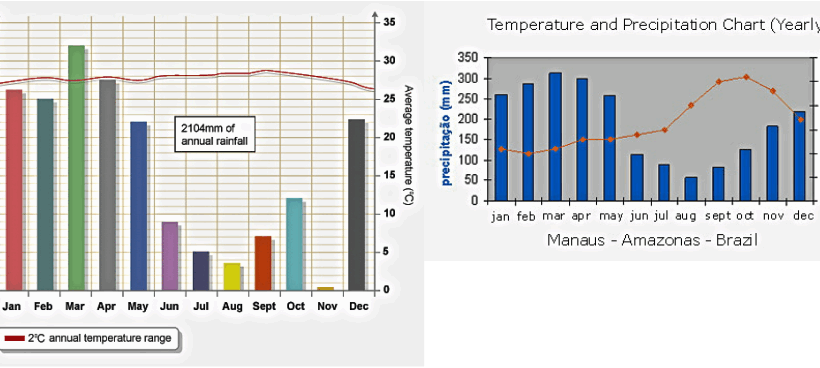The tropical rainforest is a mesmerizing ecosystem that harbors an astonishing diversity of flora and fauna. But what truly defines the climate of the tropical rainforest? Is it simply a matter of unrelenting heat and humidity? Or does it represent a complex interplay of various climatic factors? Understanding the climate of tropical rainforests is essential, not only for appreciating their beauty but also for acknowledging the urgent challenges they face in our changing world.
To commence, tropical rainforests are predominantly located near the equator, where the sun’s rays strike the Earth most directly. This positioning leads to an overall warm climate, characterized by high average temperatures that typically range between 20°C and 30°C (68°F to 86°F). The consistent warmth is a driving force behind the vibrant biodiversity that thrives in these habitats.
Equally crucial to the climate is the staggering amount of precipitation these regions receive. Tropical rainforests are often classified as ‘very humid’ environments, experiencing annual rainfall of 1750 to 2000 millimeters (69 to 79 inches) or more. The rainfall is usually distributed throughout the year, leading to lush vegetation and nurturing ecosystems teeming with life. Have you ever considered how life flourishes in such extreme humidity?
High humidity levels often hover around 77% to 88%, which creates an almost palpable atmosphere. This air saturation makes every breath feel dense and heavy, yet it is this very characteristic that provides a favorable environment for widespread plant species, particularly epiphytes and large-leafed plants. The perpetual moisture allows trees to reach towering heights, with some species growing as tall as 60 meters (197 feet), forming a vibrant canopy that shades the forest floor.
Another distinctive aspect of the climate is the lack of significant seasonal variation. While temperate regions experience four distinct seasons, tropical rainforests have a wet season and a dry season, albeit with minimal temperature fluctuation. This pattern can vary depending on geographical location, but generally, the wet season brings torrential rains, while the dry season features reduced rainfall yet maintains the characteristic warmth. This raises an intriguing question: how do the plants and animals adapt to such a consistently humid rather than seasonally fluctuating climate?
In addition to rainfall and humidity, the sunlight plays a pivotal role in shaping the rainforest climate. With abundant sunshine filtering through the dense canopy, the layers of the rainforest support a symbiotic relationship between animals, plants, and microorganisms. The upper canopy receives direct sunlight, while understory plants, which thrive in lower light conditions, have adapted to survive with little photons filtering through. Influence of the sun is profound here; it’s not merely light but a life-sustaining force that fuels the dense trophic levels of the rainforest.
Nevertheless, these lush ecosystems are under dire threat from human activity and climate change. Successful adaptation is being jeopardized as deforestation, agriculture, and urbanization encroach on these territories. Increased carbon emissions have also led to global warming, intensifying climate fluctuations even in these otherwise stable environments. As an environmentalist, one must ponder: how can we overcome the challenge of preserving the intricate balance of this ecosystem in the face of such external pressures?
Additionally, the biodiversity of these rainforests is particularly susceptible to shifts in climate patterns. Many species depend on specific humidity and temperature ranges for survival. For example, certain frogs have been observed to disappear from areas suffering from increased drought or changed precipitation patterns. As habitats alter due to climate change, extinction rates are alarmingly on the rise. It’s a grim forecast that necessitates immediate action to conserve both the species and their habitats.
Adaptation strategies are critical in the current scenario. Several communities are now employing sustainable practices that can work hand-in-hand with the conservation of tropical rainforests. Agroforestry—where crops and trees are grown together—serves as a promising method to preserve biodiversity. This allows for sustainable land use while also providing income sources for local populations. The challenge remains, however, how to implement these practices on a larger scale amidst competing economic interests.
Moreover, reforestation initiatives are also taking root in various tropical regions. They help mitigate climate impacts while restoring lost habitats. But how successful can these initiatives be if the underlying causes of deforestation and habitat loss remain unaddressed? Community involvement is paramount; locals understand their environment and are often the best stewards of its health.
In conclusion, the climate of the tropical rainforest is defined by its heat, humidity, and the delicate balance that sustains life within its confines. The lush canopies, rich biodiversity, and consistent climatic conditions contribute to an ecosystem that is nothing short of remarkable. However, as we delve deeper into understanding this climate, we must also confront the challenges posed by climate change and human activity. Addressing these concerns requires a concerted global effort, focusing on conservation, sustainable practices, and community engagement. Only through these measures can we hope to preserve these magnificent ecosystems for generations to come.








